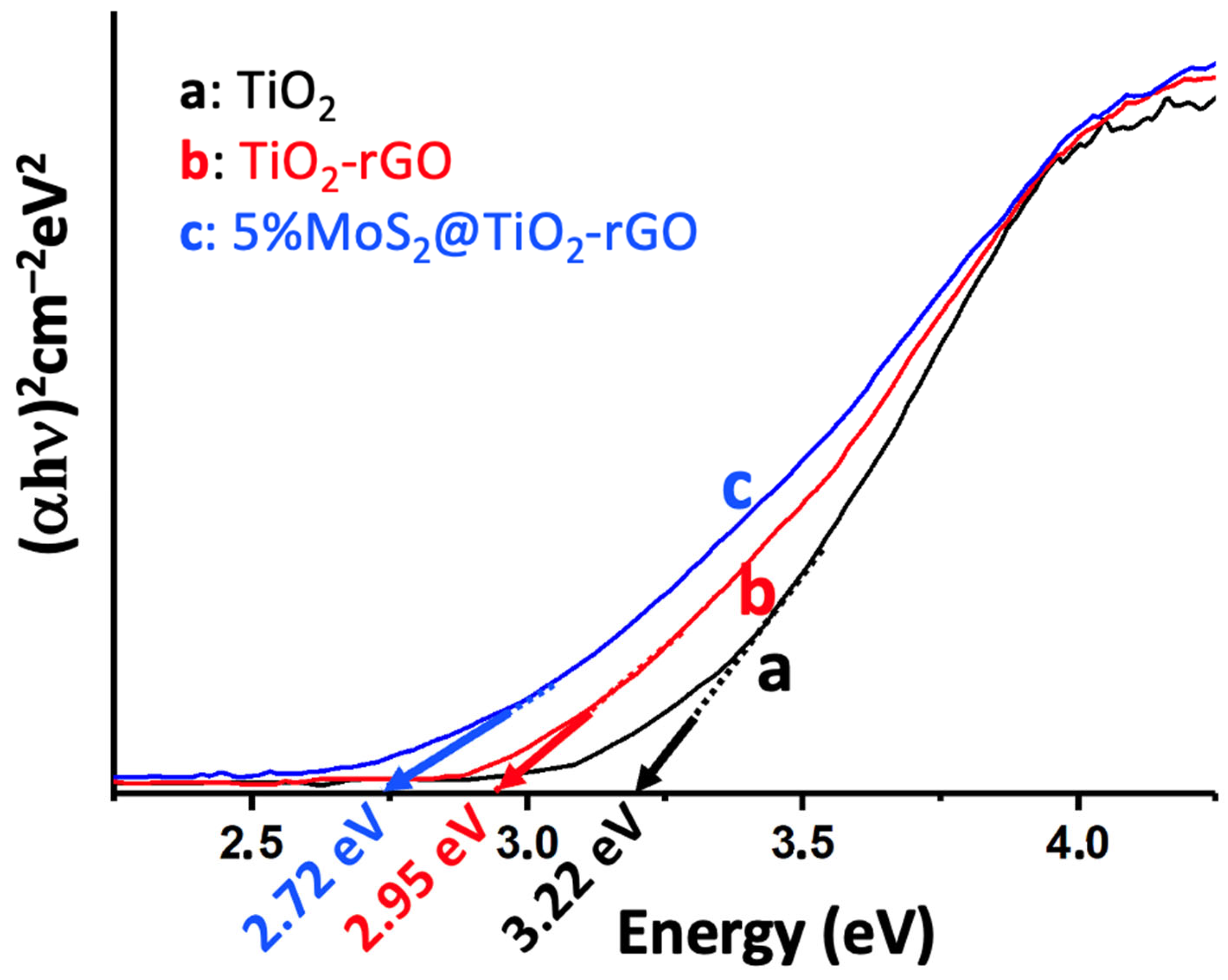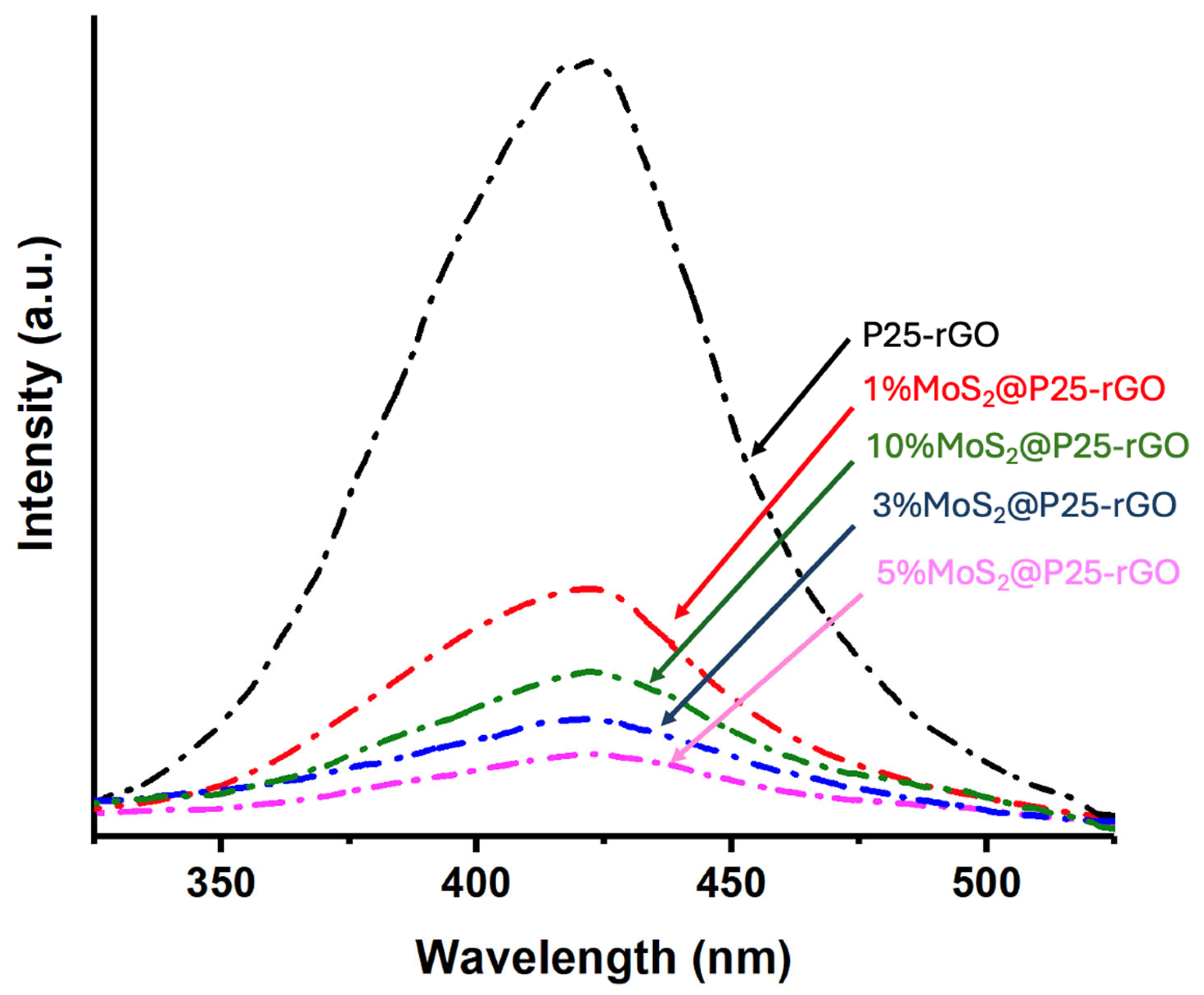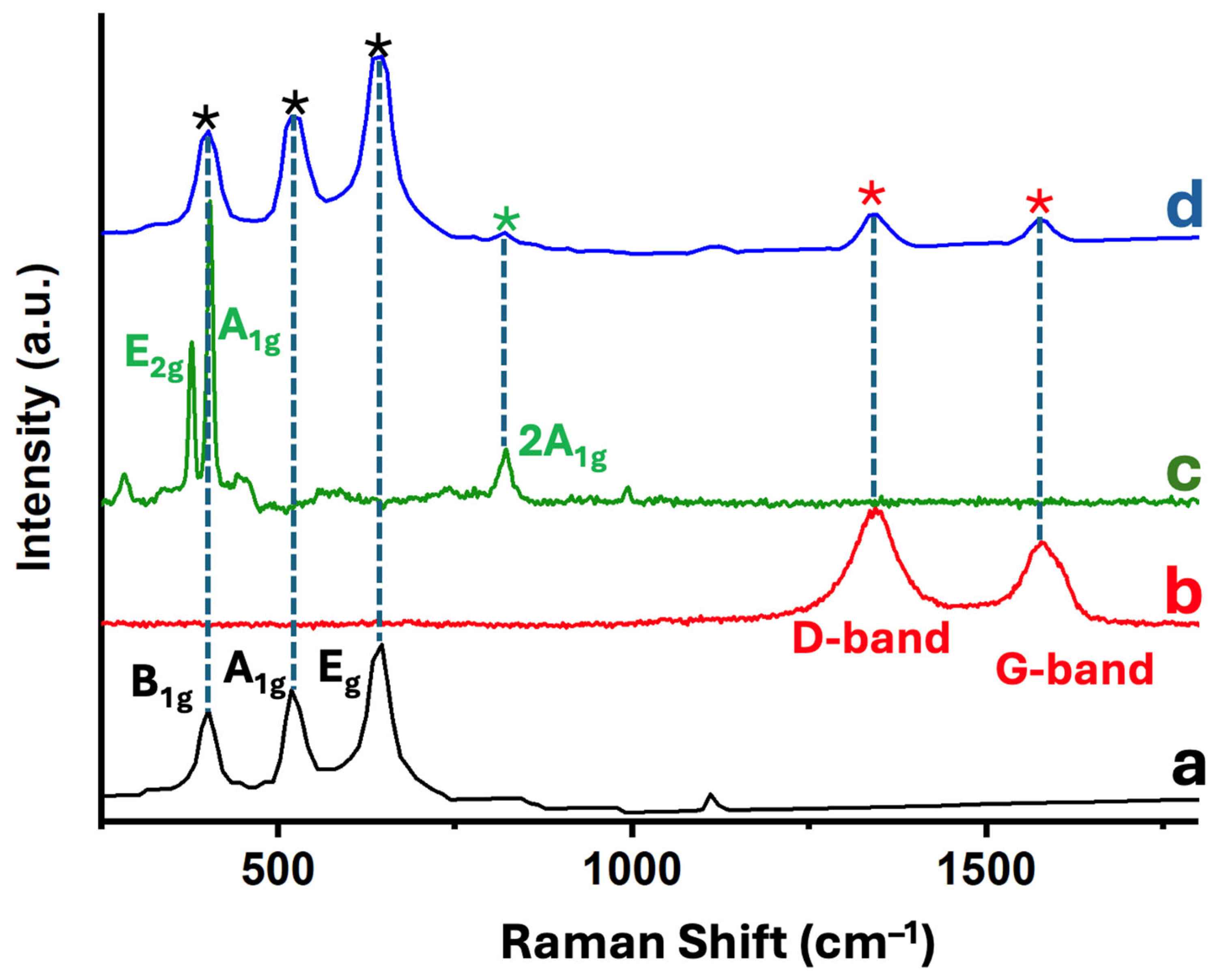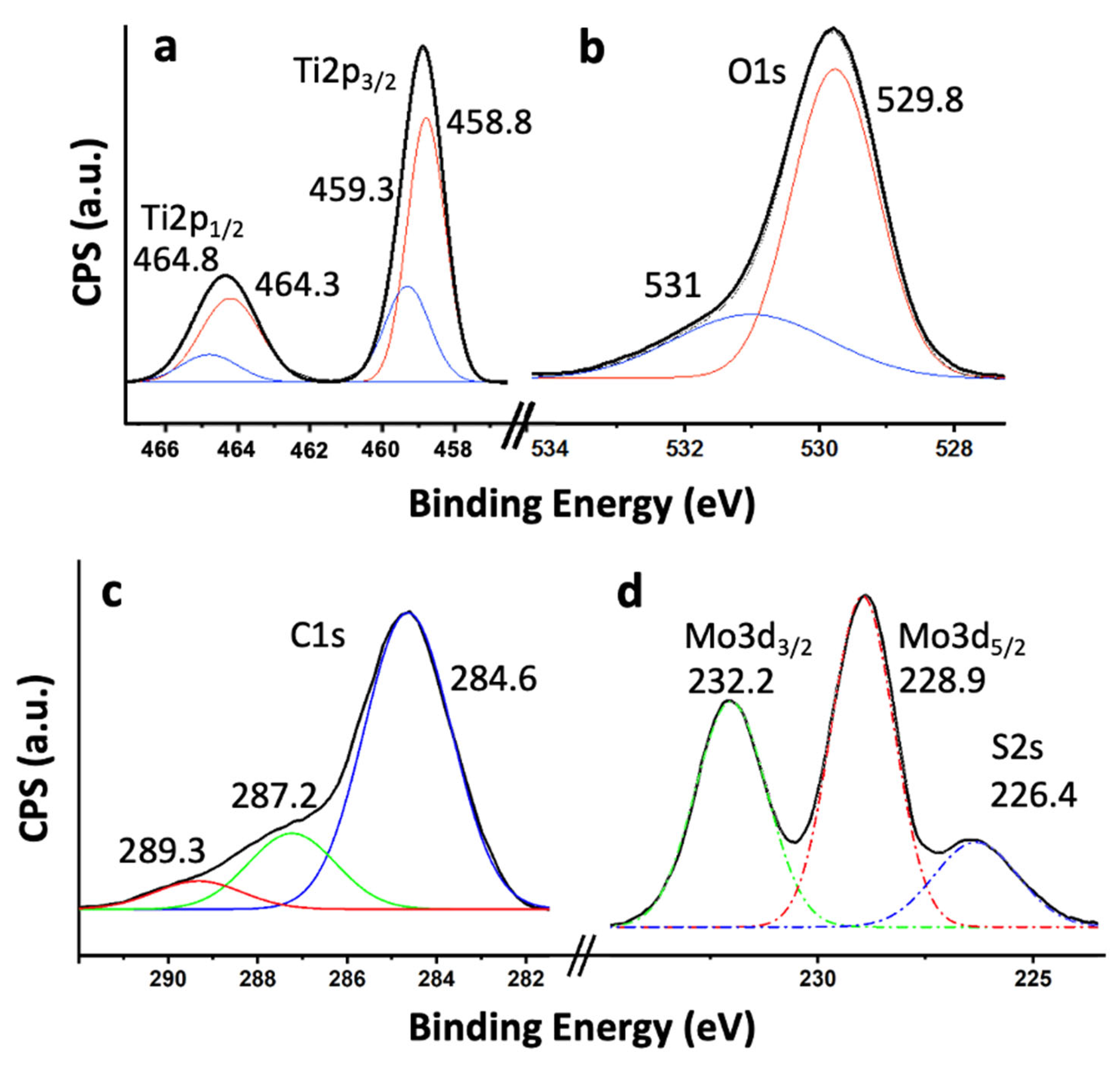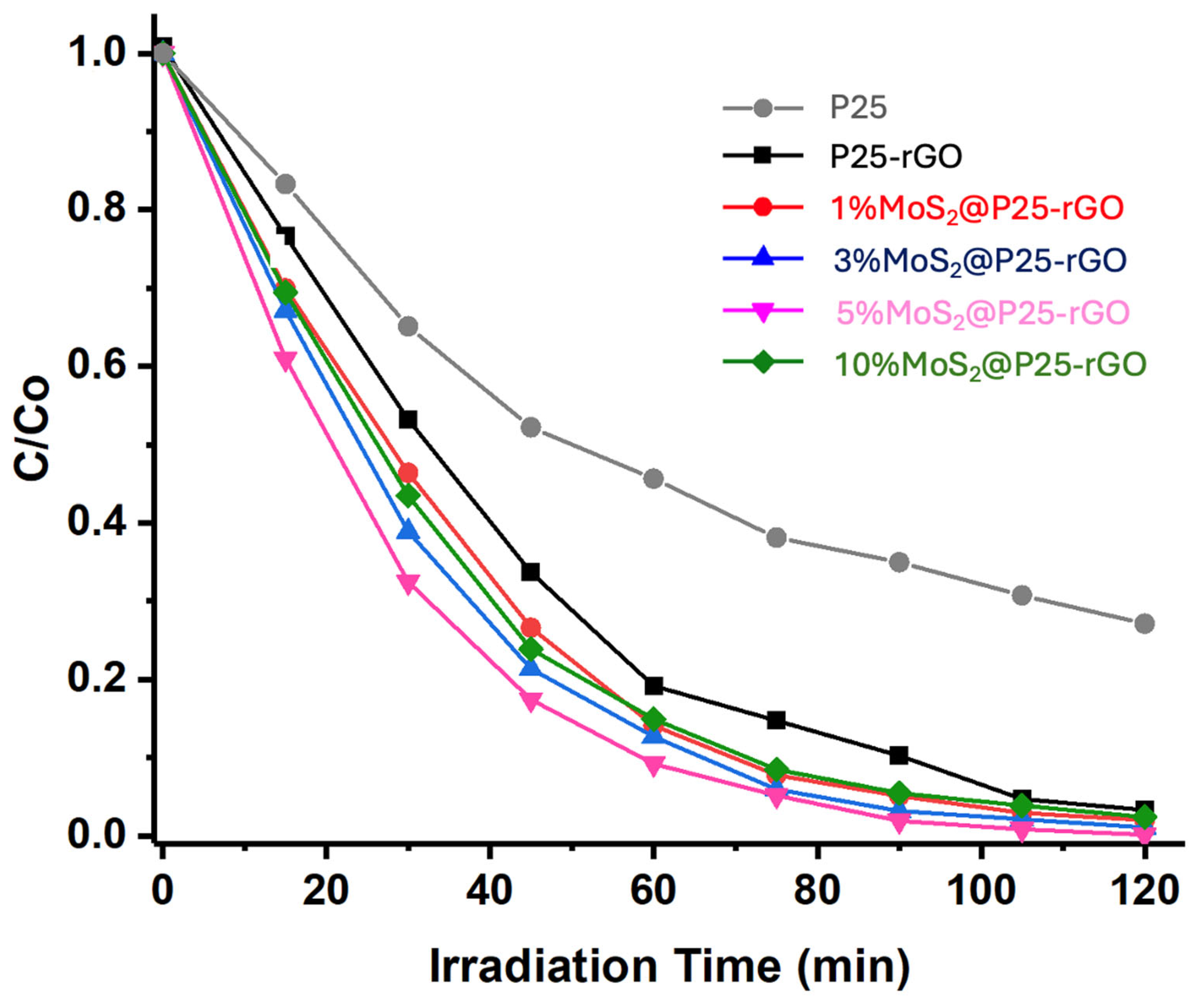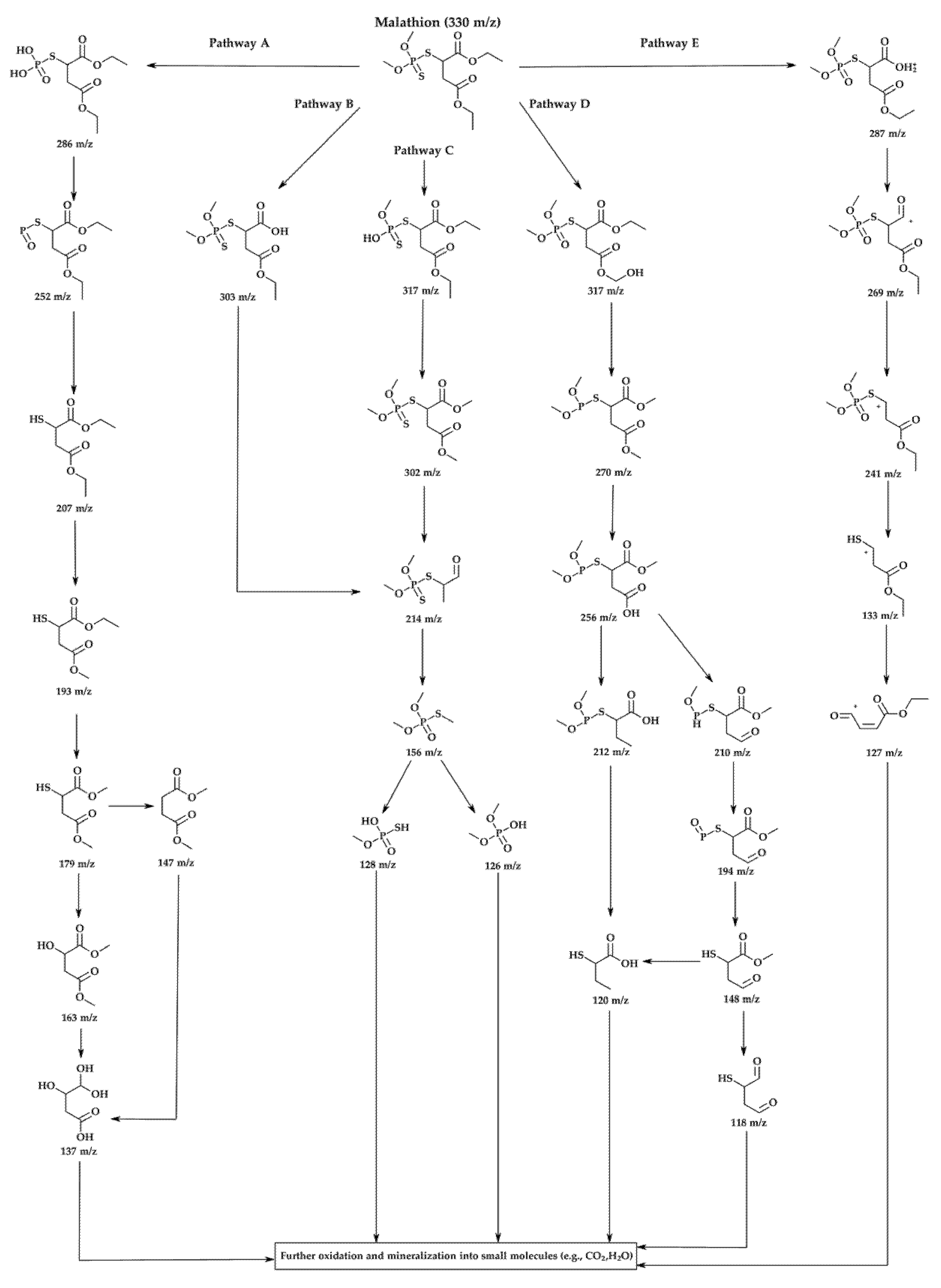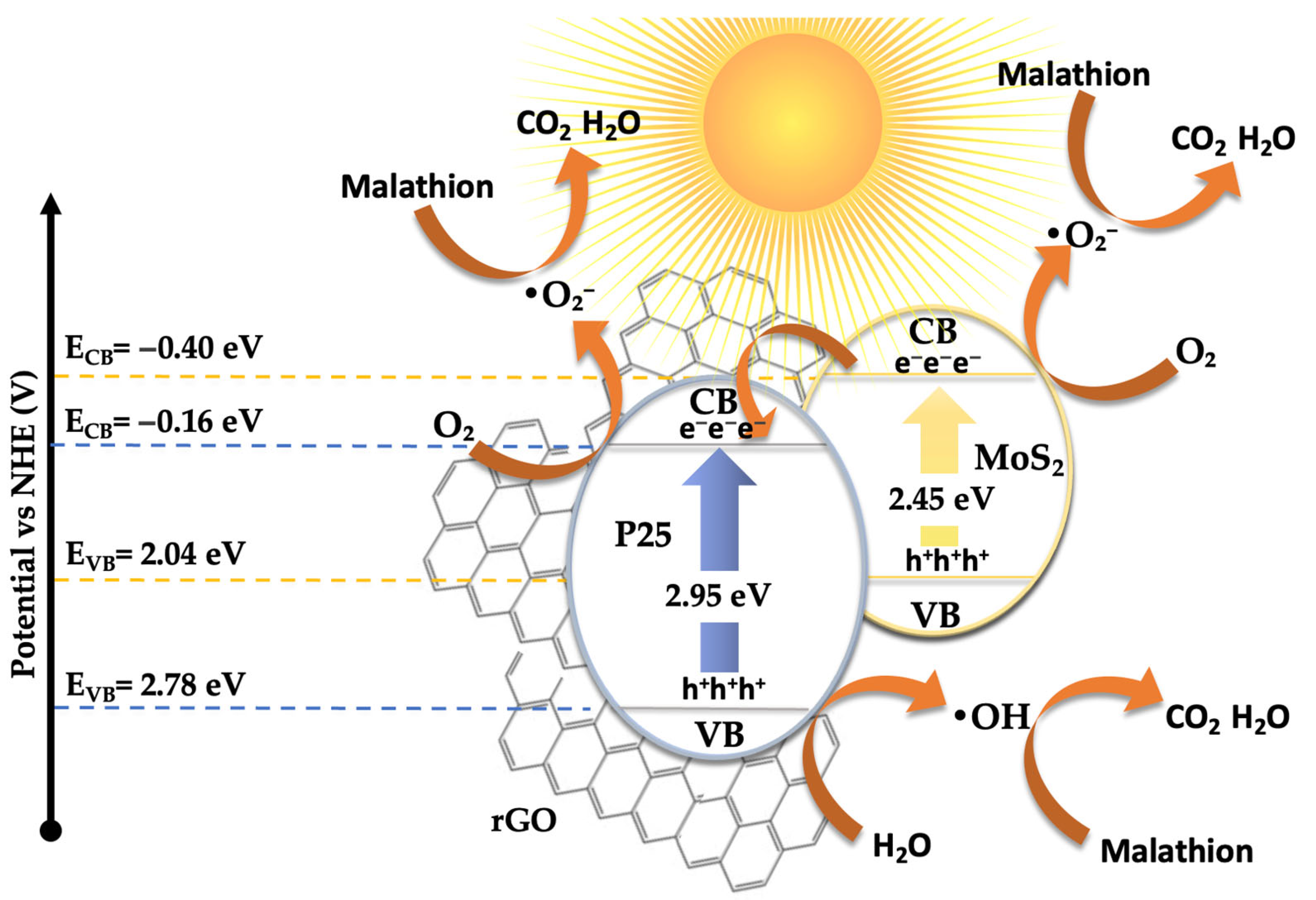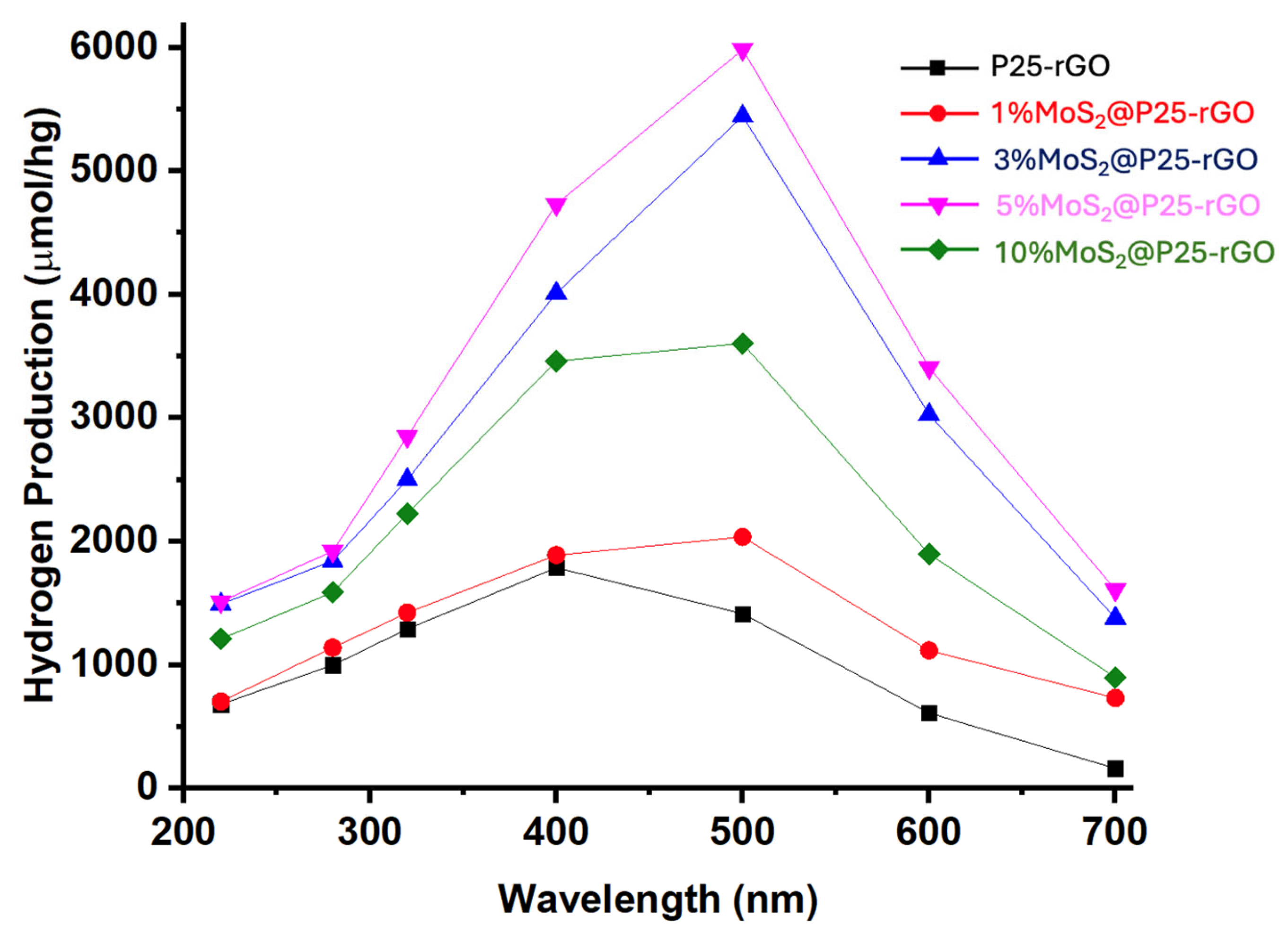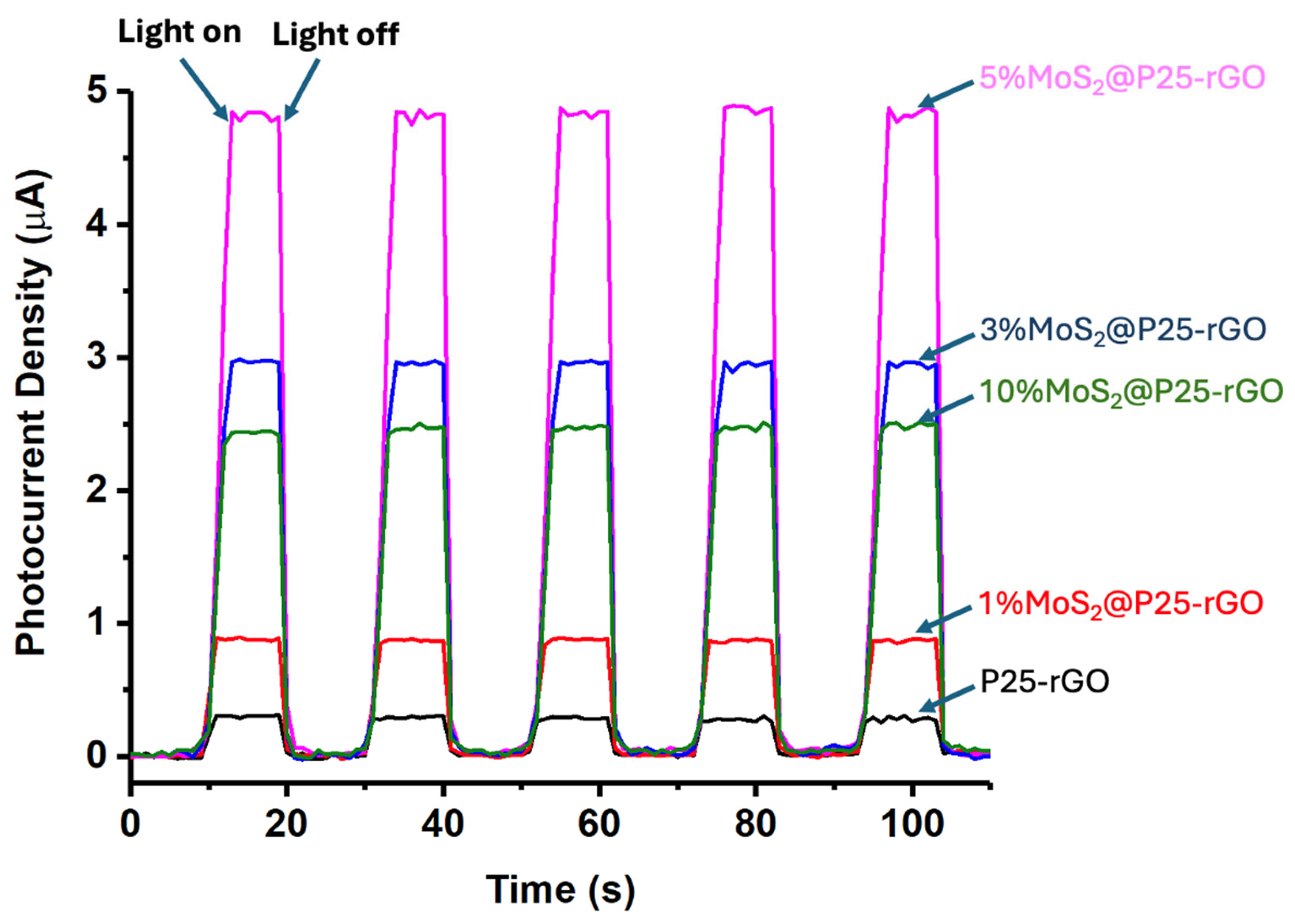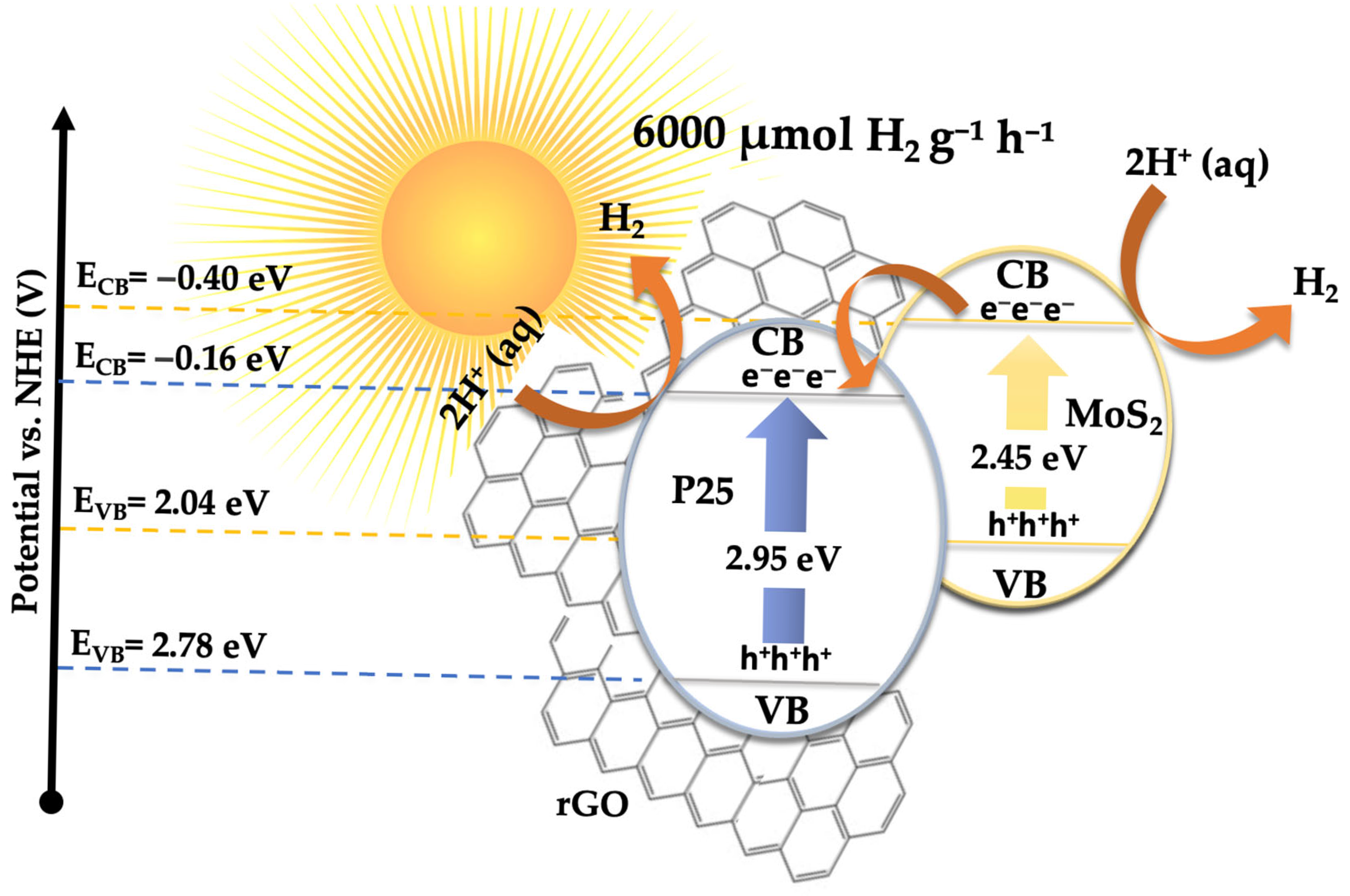3.1. Characterization of the Catalysts
Figure 1 shows SEM images of the synthesized materials at increasing magnifications. The P25-rGO support (
Figure 1a,b) exhibits an interconnected network of fibrous TiO
2 structures with lengths of several hundred nanometers and diameters of less than 20 nm. These nanofibers form a porous and open framework that facilitates mass transport and light penetration. The reduced graphene oxide (rGO) component is not distinguishable at this scale due to its low contrast and highly exfoliated nature; however, it is expected to interweave throughout the fibrous TiO
2 matrix, supporting structural cohesion and charge transport. In the MoS
2-modified catalyst (
Figure 1c), corresponding to 5 wt% MoS
2@P25-rGO, small and dispersed bright domains can be observed along the TiO
2 fibers (highlighted by yellow arrows), which are attributed to the localized deposition of MoS
2 nanosheets. These features suggest a good distribution of MoS
2 without bulk aggregation, maintaining the structural integrity of the fibrous support. This morphology agrees with reports by Gao et al. [
22] and Han et al. [
13], who observed similar nanosheet dispersion patterns in TiO
2–MoS
2–graphene composites with low MoS
2 loadings. Although individual MoS
2 nanosheets are not clearly resolved due to their low contrast and small size relative to the fibrous matrix, the presence of MoS
2 in the composites is supported by complementary techniques such as XRD, Raman, and XPS, which provide clear spectroscopic and structural evidence of its successful incorporation.
The different composites were also characterized by HRTEM (see
Figure 2).
Figure 2a shows a dense arrangement of TiO
2 nanofibers, with rGO sheets visible as faint, translucent layers enveloping the oxide structures.
Figure 2b provides a higher-resolution view of an individual TiO
2 fiber, where lattice fringes are clearly observed. The inset highlights an interplanar spacing of ca. 0.35 nm, corresponding to the (101) plane of anatase TiO
2, consistent with XRD analysis.
Figure 2c shows an HRTEM image of a single-layer MoS
2 nanosheet. This image corresponds to the exfoliated MoS
2 precursor prior to its incorporation into the composite and is included to illustrate the morphology and crystalline quality of the starting material, which is consistent with that reported in MoS
2-based heterostructures showing high HER activity [
15]. The atomically resolved honeycomb pattern indicates high structural quality and confirms the presence of monolayer MoS
2. The corresponding SAED pattern (inset) reveals a hexagonal diffraction arrangement, characteristic of the 2H-phase of MoS
2. The clear spots and absence of diffuse rings confirm high crystallinity and minimal structural defects. Although HRTEM images of the full composite are not shown here, the incorporation of MoS
2 into the P25–rGO matrix is strongly supported by structural and spectroscopic evidence; in particular, the presence of MoS
2 peaks in XRD, the detection of MoS
2-specific bands in Raman spectra, and the identification of Mo and S oxidation states in XPS collectively validate the successful formation of the ternary nanocomposite.
The crystalline phase composition of the prepared catalysts was examined by XRD (see
Figure 3). Pure P25 TiO
2 exhibits the most characteristic reflections of anatase TiO
2 at 25.5°, 38°, 48.2°, 54.4°, assigned to the (101), (004), (200), (105) planes of anatase, along with a rutile peak at ca. 27.7°, consistent with its well-known mixed-phase composition [
22]. The relative anatase-to-rutile ratio was estimated using the Spurr and Myers method [
23], based on the intensity ratio of the anatase (101) and rutile (110) peaks. The calculated ratio was approximately 80:20, in agreement with the nominal composition of commercial P25. Importantly, this mixed-phase structure was retained after the incorporation of rGO and MoS
2, as no significant changes were observed in peak position or intensity. This indicates that the crystalline integrity of TiO
2 and its phase composition were preserved throughout the synthesis. Such stability is advantageous, as the coexistence of anatase and rutile is known to enhance charge separation in photocatalysis. The TiO
2-rGO composite shows a virtually identical diffraction pattern to P25, indicating that the TiO
2 retained its crystalline structure after the graphene incorporation. Notably, no distinct new peaks attributable to graphene are observed; any potential (002) graphitic peak (~23°) is broadened or overlapped by the strong TiO
2 (101) peak [
22]. This is expected given the low loading and exfoliated nature of rGO, which lacks long-range order in stacking. Upon adding MoS
2, the composite XRD patterns still predominantly display TiO
2 reflections, but new low-angle peaks appear. In particular, a faint diffraction peak appears around 13–14° in the 5% MoS
2@TiO
2-rGO sample (see asterisk), corresponding to the (002) basal plane of hexagonal MoS
2 [
22]. An additional minor peak at ca. 33° can be discerned, matching the (100) plane of MoS
2 [
24] (see asterisk). The presence of these MoS
2 reflections confirms the successful incorporation of crystalline MoS
2 into the TiO
2-rGO matrix. These observations are in agreement with previously reported diffraction patterns for TiO
2–MoS
2 composites, where similar low-angle reflections for MoS
2 were observed without altering the TiO
2 lattice [
22,
24]. Importantly, no significant shifts in the TiO
2 peak positions are detected upon MoS
2 or rGO addition, suggesting that Mo and S are not substituting into the TiO
2 lattice, but rather that MoS
2 and rGO form an intimate heterostructure on the TiO
2 surface. The combination of TiO
2 and MoS
2 diffraction features, with no extra impurity phases, evidences the formation of the intended composite.
UV-Vis DRS was used to assess the optical absorption properties and bandgap energies of the catalysts (
Figure 4). Pristine P25 TiO
2 shows a strong absorption edge in the UV region (ca. 390 nm), corresponding to a bandgap of about 3.22 eV (consistent with anatase TiO
2) [
25]. The incorporation of rGO extends the absorption into the visible range (the TiO
2-rGO sample appears darker) with a red-shifted absorption edge. Tauc plot analysis (
Figure 4) indicates a reduced bandgap of ~2.95 eV for TiO
2-rGO, implying that the introduction of rGO facilitates visible-light absorption. This bandgap narrowing can be attributed to the electronic interaction between TiO
2 and the conductive rGO, which may introduce mid-gap states and promote the formation of an adsorption tail in the band structure. Upon loading 5% MoS
2 onto TiO
2-rGO, the absorption edge shifts further into the visible (up to ca. 455–460 nm), yielding an estimated optical bandgap of ca. 2.72 eV for the 5% MoS
2@TiO
2-rGO composite [
25]. The progressive red shift in the absorption onset from 3.22 eV (TiO
2) to 2.72 eV (MoS
2@TiO
2-rGO) confirms that the synergy of rGO and MoS
2 effectively extends the light-harvesting range of TiO
2 into the visible spectrum. This behavior is consistent with the MoS
2 acting as a narrow-bandgap sensitizer (2H-MoS
2 has a much smaller bandgap of ~1.2–1.8 eV) and the rGO acting as a photosensitizer and electron conduit [
25]. The black-colored MoS
2 nanosheets strongly absorb visible light, and when coupled with TiO
2, enable the heterostructure to use a greater portion of the solar spectrum [
25]. In addition, intimate contact between TiO
2 and MoS
2 (and rGO) can create sub-bandgap states or band bending at the interface, further contributing to the observed bandgap reduction [
26,
27]. The enhanced visible-light absorption, as evidenced by DRS, directly correlates with improved photocatalytic activity under solar irradiation; by harvesting more photons in the visible range, the MoS
2@TiO
2-rGO catalyst can generate more charge carriers for pollutant degradation and H
2 evolution compared to pure TiO
2 [
28]. This progressive bandgap narrowing matches trends observed in other ternary photocatalysts combining rGO and MoS
2 with TiO
2, as shown in works by Tien and Chen [
29] and Panchal et al. [
14], where red shifts were likewise attributed to interfacial band bending and sensitization effects.
Photoluminescence spectroscopy was used to investigate the recombination behavior of photogenerated charge carriers in the photocatalysts.
Figure 5 displays the room-temperature PL emission spectra (λ
exc = 380 nm) for P25-rGO and its composites containing different MoS
2 loadings (1%, 3%, 5%, and 10%). The P25-rGO sample exhibits a strong and broad emission band in the UV-visible range, reflecting a high rate of radiative recombination of electron–hole pairs in the absence of additional charge separation pathways [
30]. Upon incorporation of MoS
2, the PL intensity generally decreases, indicating improved charge separation due to the synergistic effects of MoS
2 and rGO [
29]. The quenching trend follows the following order: P25-rGO > 1% MoS
2@P25-rGO > 10% MoS
2@P25-rGO > 3% MoS
2@P25-rGO > 5% MoS
2@P25-rGO, with the 5% MoS
2@P25-rGO composite showing the lowest PL intensity among all tested materials. Interestingly, the composite with 10% MoS
2 exhibits a higher PL intensity than those with 3% and 5%, suggesting that excessive MoS
2 content may not be beneficial. This could be due to the agglomeration of MoS
2 layers or shielding effects that interfere with light absorption and charge transfer processes. Therefore, beyond an optimal loading, MoS
2 may hinder rather than enhance photocatalytic performance [
29]. Overall, the PL quenching confirms that moderate MoS
2 incorporation enhances charge carrier separation, while excessive loading could counteract this benefit. The significant PL reduction observed in 5% MoS
2@P25-rGO points to an optimal interfacial configuration among TiO
2, rGO, and MoS
2 that favors efficient charge extraction and transport [
24,
29,
30]. Similar PL suppression patterns have been reported by Zhang et al. [
30] and Quan et al. [
31], who attributed them to the combined role of rGO as an electron sink and of MoS
2 as an active charge-transfer co-catalyst. This agreement supports the reliability of the observed recombination trends in our system. These results are consistent with the photocatalytic activity trends, as will be discussed in a later section, where the 5% MoS
2 composite also displayed the highest performance in both malathion degradation and hydrogen evolution, confirming that suppressed electron–hole recombination is a key factor in the enhanced reactivity of these ternary composites.
Raman spectroscopy was employed to investigate the structural features and component interactions within the 5% MoS
2@TiO
2-rGO photocatalyst.
Figure 6 displays the Raman spectra of individual and composite materials: (a) TiO
2-P25, (b) rGO, (c) MoS
2, and (d) the ternary nanocomposite 5% MoS
2@TiO
2-rGO. In the spectrum of pristine TiO
2-P25 (
Figure 6a), three characteristic vibrational modes of the anatase phase are clearly observed at approximately 398 cm
−1 (B
1g), 518 cm
−1 (A
1g + B
1g), and 640 cm
−1 (E
g) [
22]. The spectrum of rGO (
Figure 6b) exhibits two prominent and broad peaks centered at ca. 1345 cm
−1 (D band) and 1590 cm
−1 (G band). The G band arises from the E
2g vibrational mode of sp
2 carbon atoms (graphitic domains), while the D band originates from defect-activated breathing modes in disordered sp
2 structures [
22]. The observed intensity ratio (I
D/I
G ≈ 0.8–1.0) suggests a partially reduced graphene oxide with residual structural defects and oxygenated functionalities, which is an expected outcome of mild reduction protocols. In the MoS
2 spectrum (
Figure 6c), the in-plane E
2g
1 mode (ca. 379 cm
−1) and the out-of-plane A
1g mode (ca. 404 cm
−1) characteristic of the 2H phase of MoS
2 are clearly observed [
30]. The band separation (~25 cm
−1) is consistent with that of few-layer MoS
2, as larger separations are typical in thinner nanosheets due to decreased interlayer interactions [
24]. A weak overtone near 990 cm
−1, attributed to the 2A
1g mode, further supports the presence of multilayer characteristics. The composite 5% MoS
2@TiO
2-rGO (
Figure 6d) presents vibrational features from all three components. The anatase TiO
2 bands (black asterisks), the rGO D and G bands (red asterisks), and the MoS
2 peaks (green asterisks) are all clearly visible, confirming the coexistence of each constituent in the hybrid structure [
30]. Importantly, no new bands or significant peak shifts are observed, suggesting that no undesirable side reactions (e.g., Mo oxidation, Ti–C bonding, or carbide formation) occurred during synthesis. These results validate the structural integrity of the ternary composite and the successful assembly of TiO
2, rGO, and MoS
2 without phase degradation. The presence of well-defined and distinct vibrational signatures from each component further implies favorable interfacial contact, which may facilitate charge separation and transport, critical factors in enhancing photocatalytic activity.
The specific surface areas of the synthesized materials were determined via nitrogen adsorption–desorption measurements using the Brunauer–Emmett–Teller (BET) method. As summarized in
Table S1, the commercial P25 TiO
2 sample exhibited a surface area of 48 m
2/g, consistent with its well-established properties. The measured BET surface area of the reduced graphene oxide (rGO) used in this study was 429 m
2/g, which aligns with values typically reported for exfoliated rGO synthesized under mild reduction conditions [
32]. Upon incorporation of reduced graphene oxide (rGO), the surface area increased substantially to 483 m
2/g, reflecting the textural contribution of rGO sheets, which help prevent TiO
2 agglomeration and promote a more open porous structure. Further addition of exfoliated MoS
2 led to a progressive increase in surface area, with values of 492, 496, 503, and 521 m
2/g for the composites containing 1%, 3%, 5%, and 10% MoS
2, respectively. These results demonstrate that the inclusion of rGO is the main contributor to the enhancement in surface area relative to bare TiO
2, while incremental increases are further achieved through MoS
2 nanosheet incorporation. This trend suggests that the introduction of layered MoS
2 contributes to additional mesoporosity and helps maintain a high surface-to-volume ratio in the hybrid system. Interestingly, however, as will be discussed in subsequent sections, the composite with 10% MoS
2, despite having the highest BET surface area, exhibited inferior photocatalytic performance in both malathion degradation and hydrogen evolution. This apparent contradiction can be explained by considering that, beyond a critical MoS
2 loading, excessive nanosheet accumulation may cause partial shielding of the TiO
2 surface, hinder interfacial charge transfer, or create electron–hole recombination centers. Although surface area is a relevant parameter in catalysis, it is not the sole determinant of photocatalytic performance. In our case, the 10% MoS
2 composite likely exhibits poor charge carrier mobility due to MoS
2 restacking or dense coverage, which can reduce photon penetration and suppress the formation of effective heterojunctions with TiO
2 and rGO. This interpretation is supported by the increased PL intensity and reduced activity observed for this sample. This highlights that surface area alone is not the determining factor for photocatalytic efficiency. This finding is consistent with prior observations by Gao et al. [
22] and Chang et al. [
25], which indicate that higher surface areas induced by excessive MoS
2 lead to decreased photocatalytic performance due to restacking and site-blocking phenomena. At higher MoS
2 contents, excessive coverage or restacking of MoS
2 layers may hinder light absorption or block active sites, disrupting the optimal heterojunction structure necessary for efficient charge separation and transfer [
33].
To investigate the surface chemical composition and oxidation states of the elements present in the 5% MoS
2@TiO
2-rGO composite, high-resolution X-ray photoelectron spectroscopy (XPS) analyses were performed (
Figure 7). The spectra confirm the presence of all key elements: Ti, O, C, Mo, and S. As shown in
Figure 7a, the high-resolution Ti 2p spectrum reveals two well-defined peaks at 458.8 eV and 464.3 eV, corresponding to Ti 2p
3/
2 and Ti 2p
1/
2, respectively, which are characteristic of Ti
4+ in TiO
2 [
34,
35]. A minor shoulder at ca. 459.3 eV may indicate surface heterogeneity or electronic interactions with MoS
2 or rGO [
36], but no significant signal is observed at lower binding energies to suggest the presence of Ti
3+ species, confirming that the TiO
2 structure remains predominantly in the fully oxidized state [
34]. The O 1s spectrum (
Figure 7b) shows a major peak at 529.8 eV attributed to lattice oxygen (Ti–O–Ti) and a secondary component at 531.0 eV, which corresponds to surface hydroxyl groups, adsorbed water, or oxygenated species on rGO [
37]. These surface oxygen functionalities are often associated with enhanced photocatalytic activity, as they can facilitate charge separation and radical formation [
37]. The C 1s spectrum (
Figure 7c) displays a dominant signal at 284.6 eV due to sp
2-hybridized carbon atoms in the graphene lattice (C=C), along with minor peaks at 287.2 eV and 289.3 eV that can be assigned to carbonyl (C=O) and carboxyl (O–C=O) groups, respectively [
32,
38]. The relatively low intensity of these oxidized carbon species confirms the successful partial reduction of graphene oxide to rGO, while the residual functional groups are beneficial for improving interfacial bonding and electron transfer between components [
39]. The Mo 3d spectrum (
Figure 7d) exhibits two main peaks, located at 228.9 eV (Mo 3d
5/
2) and 232.2 eV (Mo 3d
3/
2), characteristic of Mo
4+ in MoS
2 [
34,
40]. No additional peaks are detected in the higher binding energy range (233–235 eV), ruling out the presence of significant amounts of oxidized Mo
6+ species such as MoO
3 [
40]. In the same region, a broad feature at 226.4 eV is assigned to the S 2s signal [
41], further supporting the existence of sulfide species (S
2−) in the MoS
2 lattice [
34,
41]. Altogether, the XPS results confirm the integration of TiO
2, MoS
2, and rGO into a ternary heterostructure with minimal chemical perturbation and strong interfacial interactions. The preservation of the oxidation states of Ti
4+ and Mo
4+, along with the partial reduction of rGO, is consistent with the enhanced photocatalytic behavior observed in degradation and hydrogen evolution experiments. This electronic structure is comparable to that reported for optimized TiO
2–MoS
2–graphene hybrids exhibiting enhanced hydrogen evolution activity [
14,
34], reinforcing the proposed synergistic interaction between the components.
3.2. Photocatalytic Degradation of Malathion
To establish the optimal reaction conditions, a series of preliminary experiments were carried out using the most active material, 5% MoS
2@TiO
2-rGO, as the reference (see
Figure S1). These studies focused on evaluating the influence of key operational parameters, such as catalyst loading, the initial pH of the solution, and the presence or absence of irradiation and oxygen, on the degradation of malathion. The outcomes not only allowed us to determine the ideal experimental conditions for maximum photocatalytic efficiency but also served to confirm the photocatalytic origin of the degradation process through control experiments. These optimized parameters were subsequently applied in the evaluation of the remaining catalysts to ensure consistent and comparable performance assessments.
Figure S1a shows the effect of catalyst loading (from 0.4 to 1.8 g/L) on the photodegradation efficiency of malathion after 2 h of UV-visible irradiation. An increase in catalyst loading led to improved degradation up to an optimal concentration of 1.0 g/L, where the degradation reached nearly 100%. This enhancement is attributed to the increased number of active sites and photon absorption capacity. However, beyond this concentration, the degradation efficiency decreased significantly. At 1.6 and 1.8 g/L, degradation dropped to around 65% and 50%, respectively. This decline is likely due to increased turbidity and light scattering at higher catalyst concentrations, which reduce light penetration and active photon flux within the suspension.
Figure S1b shows the influence of the solution pH on photocatalytic degradation efficiency. Experiments were performed over a pH range of 4 to 10, keeping all other conditions constant. The photocatalytic activity showed a marked dependence on pH, with maximum degradation (ca. 100%) occurring at neutral to slightly acidic conditions (pH 6–7). Below this range, especially at pH 4, degradation efficiency decreased sharply (~60%), likely due to reduced malathion adsorption or catalyst surface protonation. In alkaline media (pH > 8), the degradation also decreased, possibly due to hydroxide ion competition or destabilization of reactive oxygen species. These results suggest that the surface charge of the photocatalyst and the speciation of malathion both influence the reaction kinetics, and that near-neutral conditions are ideal for optimal degradation. To confirm the photocatalytic nature of the malathion degradation process, a series of control tests were conducted (
Figure S1c). These included (i) photolysis (irradiation without catalyst), (ii) catalysis (catalyst in the dark), and (iii) photocatalysis under anoxic conditions (an argon-purged system). The results clearly show that significant degradation occurred only under full photocatalytic conditions (light + catalyst + air), where the malathion concentration dropped steadily over time, reaching almost complete mineralization within 120 min. In contrast, all control conditions showed minimal activity: photolysis and catalysis resulted in only minor losses (<15%), and the anoxic photocatalytic test demonstrated reduced efficiency, highlighting the essential role of dissolved oxygen as an electron acceptor in the generation of reactive oxygen species (ROS).
The photocatalytic activity of the synthesized materials was evaluated under UV-visible irradiation. Two complementary light sources were employed in this study, depending on the experimental objective. For general photocatalytic degradation and hydrogen evolution experiments, a dual 100 W halogen lamp system (Philips, warm white) was used, providing a total irradiance of approximately 6300 lux, simulating AM 1.5 solar light conditions [
20]. AM 1.5 refers to the standard terrestrial solar spectrum at mid-latitudes, where sunlight passes through 1.5 times the atmosphere relative to its path at zenith, corresponding to typical daylight conditions [
42]. In contrast, for wavelength-dependent hydrogen production studies, monochromatic light was obtained using optical bandpass filters to isolate specific wavelengths (e.g., 220, 320, 400 nm), allowing selective analysis of the photoresponse at different energy intervals. These experimental configurations are described in detail in
Section 2.5. The performance of the different catalysts—P25-rGO and MoS
2-modified composites with 1%, 3%, 5%, and 10% MoS
2—was compared under previously optimized reaction conditions (1.0 g/L catalyst loading and pH 7). As shown in
Figure 8, the pristine P25 sample exhibited the lowest degradation efficiency, highlighting its limited activity under visible-light-rich conditions and establishing a baseline for comparison. In contrast, all MoS
2-containing composites outperformed both pristine P25 and the P25-rGO sample, demonstrating the beneficial effect of MoS
2 addition. Among the tested materials, 5% MoS
2@P25-rGO exhibited the highest degradation rate, achieving near-complete removal of malathion within 120 min. This enhanced activity is attributed to the synergistic interaction among TiO
2, rGO, and MoS
2, which promotes charge separation and broadens light absorption. The 3% MoS
2 and 1% MoS
2 composites also showed significant improvements compared to the P25-rGO, but to a lesser extent. Interestingly, the 10% MoS
2@P25-rGO catalyst exhibited slightly lower activity than the 3% and 5% counterparts, likely due to excessive MoS
2 loading that can shield the active surface or induce recombination centers, corroborating the previously discussed BET and PL results. Despite having the highest measured surface area (521 m
2/g), the 10% MoS
2 composite showed limited photocatalytic efficiency. This suggests that excessive MoS
2 may form agglomerates or restacked layers that reduce the effectiveness of photon absorption and hinder charge transfer pathways within the heterostructure. As PL spectroscopy confirms, recombination becomes more pronounced with higher MoS
2 content, offsetting the benefit of additional surface area. These results indicate that achieving a balance between surface accessibility and interfacial charge dynamics is crucial, with 5% MoS
2 representing the optimal composition in this system.
To better understand the degradation mechanism of malathion using the 5% MoS
2@P25-rGO composite, a series of scavenger experiments was conducted to identify the main reactive species involved (see
Figure S2). The addition of 1,4-benzoquinone (BQ), a selective quencher of superoxide radicals (·O
2−) [
43], resulted in a pronounced decrease in degradation efficiency, strongly suggesting that ·O
2− species play a central role in the photocatalytic process [
43]. In contrast, the use of EDTA-Na
2, a hole (h
+) scavenger [
44], led to negligible inhibition, indicating that direct oxidation by photogenerated holes is not the primary degradation pathway [
44]. Similarly, the addition of tert-butanol (t-BuOH), a hydroxyl radical (·OH) scavenger [
45,
46], caused only moderate suppression, pointing to a secondary contribution of ·OH radicals [
45,
46]. These findings are consistent with a mechanism in which photoexcited electrons, generated upon UV-visible irradiation of TiO
2, are efficiently transferred to MoS
2 and/or rGO, reducing adsorbed O
2 molecules to form superoxide radicals. The layered structure and intimate contact among TiO
2, MoS
2, and rGO facilitate efficient charge separation and migration across the heterostructure, possibly through a Type-II or Z-scheme charge transfer mechanism. MoS
2, with its suitable conduction band position, acts as an electron acceptor and stabilizer, while rGO provides a rapid electron transport pathway [
15,
47]. The result is enhanced generation of ·O
2− species, which act as the dominant oxidizing agents responsible for the breakdown of malathion.
A detailed GC-MS analysis was conducted to elucidate the photocatalytic degradation pathway of malathion under UV-visible irradiation using the most active catalyst, 5% MoS
2@P25-rGO (
Figure 9). Reaction aliquots were collected at different irradiation times and analyzed to identify intermediate products based on their mass-to-charge (
m/
z) ratios. The parent compound, malathion (
m/
z = 330), was progressively decomposed through a sequence of hydrolytic and oxidative transformations. Five main degradation pathways (A–E) were proposed based on the detected fragments and their temporal evolution, as illustrated in
Figure 9. In Pathway A, the hydrolysis of ester bonds and ring opening resulted in the formation of lower-mass products [
48]. Pathways B and C involve oxidative desulfuration and P–S bond cleavage, producing fragments such as
m/
z 303, 302, 214, and 156 [
49,
50,
51,
52]. Pathway D comprises further oxidation and sulfur removal, generating species at
m/
z 317, 270, and 256 [
48], while Pathway E involves oxidative demethylation and side-chain fragmentation, yielding intermediate ions like
m/
z 287, 241, and 133 [
53]. The presence of low-molecular-weight fragments (
m/
z 128, 126, 137) indicates the occurrence of advanced oxidation processes, suggesting partial mineralization of malathion into CO
2 and H
2O, consistent with the mineralization trends observed in other TiO
2-based systems. Importantly, the formation of intermediates such as
m/
z 214 and 156 supports the predominant role of superoxide radicals (·O
2−) as oxidative agents, consistent with the radical trapping experiments discussed previously [
54,
55]. The heterostructure of TiO
2, MoS
2, and rGO favors efficient charge separation and facilitates electron transfer to molecular oxygen, sustaining the generation of reactive oxygen species (ROS). MoS
2, due to its narrow bandgap and appropriate conduction band alignment, acts as an effective electron sink, while rGO enhances electron transport and surface dispersion. This synergistic configuration promotes a Z-scheme or Type II-like mechanism that enhances photoinduced redox activity [
56]. Altogether, the results demonstrate that the 5% MoS
2@P25-rGO catalyst enables efficient and multi-step degradation of malathion via concurrent hydrolytic and oxidative pathways, ultimately leading to detoxification of the pollutant and partial mineralization under mild conditions.
To ensure the practical viability of the developed photocatalysts, long-term operational stability and reusability were also evaluated. In this context, a recyclability study was conducted using the most active material, 5% MoS
2@P25-rGO, to assess its performance over successive degradation cycles. As shown in
Figure S3, the photocatalyst maintained nearly constant activity throughout 10 consecutive runs, with only a slight decline of approximately 4.7% in degradation efficiency. This stability underscores the structural robustness and chemical durability of the MoS
2-rGO-TiO
2 heterojunction, confirming its suitability for repeated use in aqueous photocatalytic systems under UV-visible light irradiation.
Based on all the results presented above, a plausible mechanism for the photocatalytic degradation of malathion has been proposed, as illustrated in
Figure 10. The electronic band structure and the migration direction of photogenerated charge carriers were estimated using the Mulliken electronegativity theory [
57,
58,
59,
60]. This approach, originally introduced by R. S. Mulliken [
60], relates the absolute electronegativity (χ) of a material to its ability to attract electrons. In this context, χ is defined as the arithmetic mean of the first ionization energy and the electron affinity of the compound and reflects its electron-attracting strength. For compound semiconductors such as TiO
2 and MoS
2, χ values are typically derived from weighted averages of their constituent atomic electronegativities and are available in the literature [
60]. The band edge potentials were calculated using the following equations [
57]:
where E
CB and E
VB are the conduction and valence band edge potentials (in eV), Eg is the bandgap energy of the semiconductor (determined from UV-Vis DRS), E
C is the energy of free electrons on the hydrogen scale (taken as 4.50 eV) [
61], and χ is the absolute electronegativity of the semiconductor compound, estimated from tabulated values.
The calculated electronic parameters used for this estimation are summarized in
Table 1. These include the absolute electronegativity (χ), optical bandgap (Eg), and the resulting conduction and valence band edge potentials (E
CB and E
VB) for the main semiconducting components in the composite system.
Based on this model, the calculated band edge positions for P25-rGO are E
CB = −0.165 eV and E
VB = +2.785 eV, while for MoS
2, they are E
CB = −0.405 eV and E
VB = +2.045 eV. Under visible light irradiation, TiO
2 (P25) is largely inactive due to its wide bandgap (~3.2 eV) [
62]. However, MoS
2 and rGO, with narrower bandgaps, can absorb visible photons and become photoexcited [
63]. In the case of MoS
2, visible light promotes electrons from the valence band to the conduction band, leaving behind holes. These photoexcited electrons, due to the more negative conduction band of MoS
2 (–0.405 eV) relative to P25-rGO (–0.165 eV), can transfer to the TiO
2–rGO interface, where they are readily scavenged by molecular oxygen dissolved in the medium. This reduction leads to the formation of superoxide radicals (·O
2−), which are highly reactive and capable of oxidizing malathion. Simultaneously, holes remaining in the MoS
2 and photoinduced holes in the rGO may weakly contribute to oxidation, although scavenger experiments indicate that their role is secondary (see
Figure S2). Instead, hydroxyl radicals (·OH), generated from water or hydroxide oxidation by valence band holes in the TiO
2, provide an additional oxidative pathway. The high surface area of rGO facilitates these processes by providing a large number of adsorption and reaction sites while also improving charge mobility and suppressing recombination via rapid electron conduction [
64]. The dominant degradation route, as supported by radical quenching experiments and GC-MS analysis, is thus initiated by ·O
2− radicals attacking the ester and phosphorothioate bonds in malathion, leading to a stepwise oxidative fragmentation into less toxic and lower-molecular-weight intermediates. This mechanism is fully consistent with the observed suppression of activity upon the addition of 1,4-benzoquinone (a ·O
2− scavenger), as well as with the enhanced photocatalytic activity shown by the 5% MoS
2@P25-rGO composite compared to binary or unmodified systems. The proposed mechanism involves a type-II heterojunction [
65], in which MoS
2 and rGO sensitize the composite to visible light [
14], and the hierarchical structure promotes directional charge transfer from MoS
2 to TiO
2–rGO [
31]. This configuration enables the generation of reactive oxygen species—mainly superoxide and, to a lesser extent, hydroxyl radicals—which drive the oxidative degradation of malathion under solar-like irradiation conditions.
3.3. Photocatalytic Hydrogen Production
As performed for the malathion photodegradation studies, a similar approach was employed to determine the optimal conditions for photocatalytic hydrogen production (
Figure S4). The influence of catalyst loading on the photocatalytic hydrogen production performance of the most active nanocomposite, 5% MoS
2@P25-rGO, was first investigated (
Figure S4a). The hydrogen evolution rate increased with catalyst concentration up to an optimal loading of 1.0 g L
−1, reaching a maximum yield of nearly 6000 µmol g
−1 h
−1. Beyond this point, the activity decreased, likely due to excessive light scattering, increased turbidity, and the agglomeration of photocatalyst particles, which limit light penetration and reduce the number of accessible active sites. At lower catalyst dosages, the lower availability of surface-active regions similarly limits the overall rate of hydrogen generation. The effect of solution pH on hydrogen production was subsequently evaluated (
Figure S4b). The system exhibited optimal performance under neutral conditions (pH = 7), where both charge carrier separation and proton availability are favorably balanced. In strongly acidic environments (pH = 4), the excessive concentration of H
+ ions can hinder charge mobility and promote recombination. Conversely, under alkaline conditions (pH = 10), the reduced proton concentration limits the supply of reactants necessary for H
2 evolution, leading to a significant drop in photocatalytic efficiency [
66]. To confirm the photocatalytic nature of the observed hydrogen generation, control experiments were conducted under different conditions (
Figure S4c). Negligible H
2 evolution was detected in the absence of either the catalyst or light, confirming that both components are essential for the reaction to proceed. These results validate that the process is strictly photo-driven and demonstrate the synergy among MoS
2, TiO
2, and rGO in facilitating efficient light-induced hydrogen evolution.
To further assess the photocatalytic performance of the optimized 5% MoS
2@P25-rGO composite, the apparent quantum efficiency (AQE) was calculated under monochromatic irradiation at 500 nm. The AQE was determined using the following standard expression:
The experiment was conducted using 50 mg of catalyst irradiated over 10 cm
2 for 2 h at 500 nm, with a light intensity of 120 mW·cm
−2. Under these conditions, the total hydrogen evolution was 600 µmol·g
−1·h
−1, resulting in an AQE of approximately 3.33%. The detailed calculation steps, including photon flux estimation and hydrogen quantification, are provided in the
Supplementary Information (Table S2). This value is consistent with previously reported ternary TiO
2-based systems incorporating MoS
2 and rGO and supports the efficient utilization of visible photons in the hydrogen evolution process [
67,
68].
Figure 11 shows the wavelength-dependent hydrogen production profiles, clearly highlighting the superior photocatalytic activity of the MoS
2-modified P25-rGO composites relative to the unmodified P25-rGO system. As a function of the incident photon energy, all catalysts show enhanced activity within the 300–500 nm range, where the absorption of UV and visible light is most efficient. Among the materials studied, the 5% MoS
2@P25-rGO nanocomposite exhibits the highest hydrogen evolution rate, reaching nearly 6000 µmol g
−1 h
−1 at 500 nm. This outstanding activity can be rationalized by the formation of an efficient heterojunction among TiO
2, MoS
2, and rGO, which synergistically enhances charge separation, interfacial charge transfer, and visible-light absorption. TiO
2 serves as a stable wide-bandgap photocatalyst with strong UV absorption, while rGO provides a conductive platform that facilitates electron mobility, reduces charge recombination, and promotes light harvesting through its extended π-conjugated system [
69]. The incorporation of MoS
2 introduces a narrow-bandgap semiconductor with well-known catalytic activity for the hydrogen evolution reaction (HER), which then acts as a co-catalyst, offering abundant active edge sites and lowering the overpotential required for proton reduction [
70]. The observed activity trend—5% MoS
2 > 3% MoS
2 > 10% MoS
2 > 1% MoS
2 > P25-rGO—clearly indicates that a moderate MoS
2 loading is optimal for balancing these effects. At 1% MoS
2, the number of catalytically active sites is likely insufficient to significantly improve HER kinetics, whereas an excessive amount of MoS
2 (e.g., 10%) could lead to detrimental effects such as nanoparticle agglomeration, light shielding, and partial coverage of TiO
2 or rGO surfaces, thereby impeding photon absorption and reducing charge accessibility. Additionally, the decline in activity observed beyond 500 nm is consistent with the intrinsic bandgap limitations of the semiconductor components, as the photon energy becomes inadequate to excite electrons from the valence to the conduction band. These findings support that the careful modulation of MoS
2 content within the ternary composite is essential to maximize photocatalytic efficiency, and they emphasize the importance of interfacial engineering, band alignment, and light absorption optimization in designing next-generation nanostructured materials for sustainable hydrogen production.
The long-term performance and mechanistic aspects of the photocatalytic hydrogen evolution reaction (HER) using MoS
2@P25-rGO composites were further examined through a series of complementary experiments, including transient photocurrent measurements, scavenger assays, and recyclability tests. The photocurrent responses under chopped light illumination (
Figure 12) provide direct insight into the efficiency of photogenerated charge separation and transport. The 5% MoS
2@P25-rGO catalyst exhibited the highest photocurrent density (~5 μA), followed by 3% MoS
2@P25-rGO, 10% MoS
2@P25-rGO, 1% MoS
2@P25-rGO, and finally the unmodified P25-rGO. This order of photocurrent response precisely mirrors the trend observed in photocatalytic hydrogen production (
Figure 11) and also aligns with the photocatalytic activity for malathion degradation discussed in earlier sections. These consistent trends across multiple techniques confirm that the enhanced photoactivity of the 5% MoS
2 composite is directly linked to its superior charge separation and transport characteristics, which are facilitated by the synergistic interactions among MoS
2, P25, and rGO.
To further clarify the mechanistic pathway of HER, radical scavenger experiments were conducted using EDTA-Na
2, a known hole scavenger (see
Figure S5) [
44]. The addition of EDTA resulted in a significant enhancement in H
2 production across the tested wavelengths compared to the control without the scavenger. This suggests that photogenerated holes act as recombination centers or engage in parallel oxidative reactions, and that their suppression enables a higher fraction of electrons to participate in proton reduction. These results support the hypothesis that MoS
2 not only facilitates electron transfer but also serves as an efficient co-catalyst for proton reduction, with rGO acting as an electron mediator that enhances interfacial conductivity [
15,
71].
In terms of practical application, the recyclability of the 5% MoS
2@P25-rGO photocatalyst was evaluated over 10 consecutive HER cycles (
Figure S6). The system retained 91.9% of its initial hydrogen production capacity after 10 uses, with a performance drop of only 8.1%. This photostability underscores the structural robustness of the heterostructure and the durability of the active sites, confirming the feasibility of this material for long-term solar hydrogen generation. The strong interfacial bonding among MoS
2, TiO
2, and rGO components likely prevents leaching or deactivation, maintaining catalytic integrity over multiple uses. Taken together, these findings demonstrate the strong correlation among photocatalytic performance, charge transport efficiency, and material stability, positioning 5% MoS
2@P25-rGO as a promising candidate for sustainable hydrogen production.
Based on the previously discussed results, a plausible mechanism has been proposed to explain the photocatalytic hydrogen evolution activity, consistent with the experimental observations (see
Figure 13). The outstanding H
2 production performance of the 5% MoS
2@P25-rGO photocatalyst arises from the interplay among its three constituents—TiO
2 (P25), MoS
2, and reduced graphene oxide (rGO)—which together form a hierarchical heterostructure capable of efficient light absorption, charge separation, and catalytic functionality under visible-light irradiation. Among them, MoS
2 acts as the primary absorber of visible light. Upon irradiation, electrons are promoted from its valence band (VB) to its conduction band (CB), leaving behind photogenerated holes. TiO
2 (P25), with a wider bandgap (~3.2 eV), is less responsive to visible light; however, the incorporation of MoS
2 and rGO into the structure redshifts the optical absorption of the composite, allowing some activation of TiO
2 under solar-simulated conditions. Moreover, interfacial interactions can induce localized mid-gap states, enhancing visible-light response. Band edge calculations based on Mulliken’s electronegativity theory suggest that the CB potential of MoS
2 (–0.405 eV vs. NHE) is more negative than that of TiO
2 (–0.165 eV), while TiO
2 has a more positive VB (+2.785 eV), making it a potent oxidant. This band alignment favors a directional flow of charge carriers: electrons generated in TiO
2 or MoS
2 transfer toward MoS
2 and rGO, while holes accumulate on TiO
2 [
72]. Additionally, rGO acts as a conductive electron mediator that bridges MoS
2 and TiO
2, facilitating ultrafast charge transfer and delocalization, while also serving as a high-surface-area scaffold for active site dispersion [
39]. This spatial charge separation is further evidenced by the strong quenching of photoluminescence (PL) in the composite and its enhanced transient photocurrent response, which indicate suppressed electron–hole recombination. The 5% MoS
2@P25-rGO composite shows the highest photocurrent density and the lowest PL intensity among all tested samples, consistent with its superior H
2 production rates. At the MoS
2 surface, electrons reduce protons (H
+) from the solution to generate H
2, taking advantage of the abundant and catalytically active edge sites on MoS
2. Meanwhile, the holes in TiO
2 oxidize sacrificial agents added to the solution, preventing recombination and sustaining the redox cycle. Scavenger experiments confirm that hole consumption significantly enhances H
2 evolution, highlighting the importance of maintaining separate pathways for electrons and holes. This mechanism is consistent with that proposed for malathion degradation, where the same spatial charge separation and vectorial charge migration were identified. In the absence of oxygen, electrons that would otherwise reduce O
2 (to form ·O
2− for oxidative degradation) are now fully available for proton reduction, thus explaining the high H
2 evolution rates. The rGO sheets not only improve the conductivity and dispersibility of MoS
2 but also ensure intimate contact among the components, which is essential for maintaining an efficient interfacial electric field and continuous charge flow [
73,
74]. Overall, the 5% MoS
2@P25-rGO catalyst operates via a cooperative mechanism that combines light absorption, charge generation, and catalytic functionality across its components. The result is a system capable of exploiting a broad portion of the solar spectrum while maintaining low recombination losses and high redox activity, delivering significant hydrogen generation rates and demonstrating its promise for sustainable solar fuel applications.



